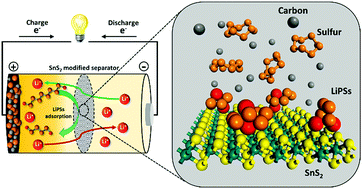当前位置:
X-MOL 学术
›
Nanoscale Horiz.
›
论文详情
Our official English website, www.x-mol.net, welcomes your
feedback! (Note: you will need to create a separate account there.)
Tin sulfide modified separator as an efficient polysulfide trapper for stable cycling performance in Li–S batteries†
Nanoscale Horizons ( IF 8.0 ) Pub Date : 2018-09-19 00:00:00 , DOI: 10.1039/c8nh00172c Brindha Moorthy 1, 2, 3, 4 , Soonho Kwon 1, 2, 3, 4 , Joo-Hyung Kim 1, 2, 3, 4 , P. Ragupathy 1, 2, 3, 4, 5 , Hyuck Mo Lee 1, 2, 3, 4 , Do Kyung Kim 1, 2, 3, 4
Nanoscale Horizons ( IF 8.0 ) Pub Date : 2018-09-19 00:00:00 , DOI: 10.1039/c8nh00172c Brindha Moorthy 1, 2, 3, 4 , Soonho Kwon 1, 2, 3, 4 , Joo-Hyung Kim 1, 2, 3, 4 , P. Ragupathy 1, 2, 3, 4, 5 , Hyuck Mo Lee 1, 2, 3, 4 , Do Kyung Kim 1, 2, 3, 4
Affiliation

|
Lithium–sulfur batteries (Li–S) are considered the most promising systems for next-generation energy storage devices due to their high theoretical energy density and relatively low cost. However, the practical applications of Li–S batteries are hindered by the poor electronic conductivity of sulfur and capacity degradation resulting from the shuttle effect of lithium polysulfides (LiPSs). Herein, we demonstrate use of a tin-sulfide (SnS2) modified separator to facilitate the redox reaction involving LiPS intermediates and realize improved electrochemical performance in a Li–S battery. Density functional theory (DFT) calculations revealed that SnS2 exhibits a strong affinity with LiPSs and induces a rapid conversion of trapped polysulfides. As a result, Li–S batteries with a SnS2-modified separator exhibited an enhanced specific capacity of 1300 mA h g−1 at 0.2C (corresponding to a high areal capacity of 4.03 mA h cm−2), which was maintained at 1040 mA h g−1 after 150 cycles. Furthermore, an excellent rate capability is achieved with a capacity of 700 mA h g−1 (2.17 mA h cm−2) at 5C. Additionally, the modified separator exhibited excellent cycling performance up to 500 cycles at 2C, with a low capacity decay rate of 0.0710% per cycle. The excellent performance of the sulfur electrode is mainly attributed to the incorporation of the SnS2 coating layer on the separator, which effectively confines polysulfides via both chemical and physical interaction and rapidly improves lithium ion diffusion. Moreover, the SnS2 coating layer greatly improves sulfur utilization and efficiently accelerates the kinetic conversion of trapped polysulfides.
中文翻译:

硫化锡修饰的隔膜是高效的多硫化物捕集器,可在Li–S电池中实现稳定的循环性能†
锂硫电池(Li–S)由于具有较高的理论能量密度和相对较低的成本,因此被认为是下一代储能设备最有希望的系统。然而,锂硫电池的实际应用受到硫的不良电导率和多硫化锂(LiPSs)的穿梭效应导致的容量下降的阻碍。在本文中,我们演示了使用硫化锡(SnS 2)改性隔膜来促进涉及LiPS中间体的氧化还原反应,并改善Li-S电池的电化学性能。密度泛函理论(DFT)计算表明,SnS 2与LiPSs表现出很强的亲和力,并引起捕获的多硫化物的快速转化。结果,带有SnS的Li-S电池2-改性隔板在0.2C下显示出比电容量增加的1300 mA hg -1(对应于4.03 mA h g cm -2的高面积容量),其在150次循环后保持在1040 mA hg -1。此外,在5℃下以700mA hg -1(2.17mA h cm -2)的容量实现了优异的速率能力。此外,改进的隔膜在2C时最多500个循环中表现出出色的循环性能,每循环0.0710%的低容量衰减率。硫电极的出色性能主要归因于在隔板上引入了SnS 2涂层,该涂层有效地限制了多硫化物的产生。化学和物理相互作用,并迅速改善锂离子扩散。此外,SnS 2涂层大大提高了硫的利用率,并有效地加速了被捕集的多硫化物的动力学转化。
更新日期:2018-09-19
中文翻译:

硫化锡修饰的隔膜是高效的多硫化物捕集器,可在Li–S电池中实现稳定的循环性能†
锂硫电池(Li–S)由于具有较高的理论能量密度和相对较低的成本,因此被认为是下一代储能设备最有希望的系统。然而,锂硫电池的实际应用受到硫的不良电导率和多硫化锂(LiPSs)的穿梭效应导致的容量下降的阻碍。在本文中,我们演示了使用硫化锡(SnS 2)改性隔膜来促进涉及LiPS中间体的氧化还原反应,并改善Li-S电池的电化学性能。密度泛函理论(DFT)计算表明,SnS 2与LiPSs表现出很强的亲和力,并引起捕获的多硫化物的快速转化。结果,带有SnS的Li-S电池2-改性隔板在0.2C下显示出比电容量增加的1300 mA hg -1(对应于4.03 mA h g cm -2的高面积容量),其在150次循环后保持在1040 mA hg -1。此外,在5℃下以700mA hg -1(2.17mA h cm -2)的容量实现了优异的速率能力。此外,改进的隔膜在2C时最多500个循环中表现出出色的循环性能,每循环0.0710%的低容量衰减率。硫电极的出色性能主要归因于在隔板上引入了SnS 2涂层,该涂层有效地限制了多硫化物的产生。化学和物理相互作用,并迅速改善锂离子扩散。此外,SnS 2涂层大大提高了硫的利用率,并有效地加速了被捕集的多硫化物的动力学转化。











































 京公网安备 11010802027423号
京公网安备 11010802027423号